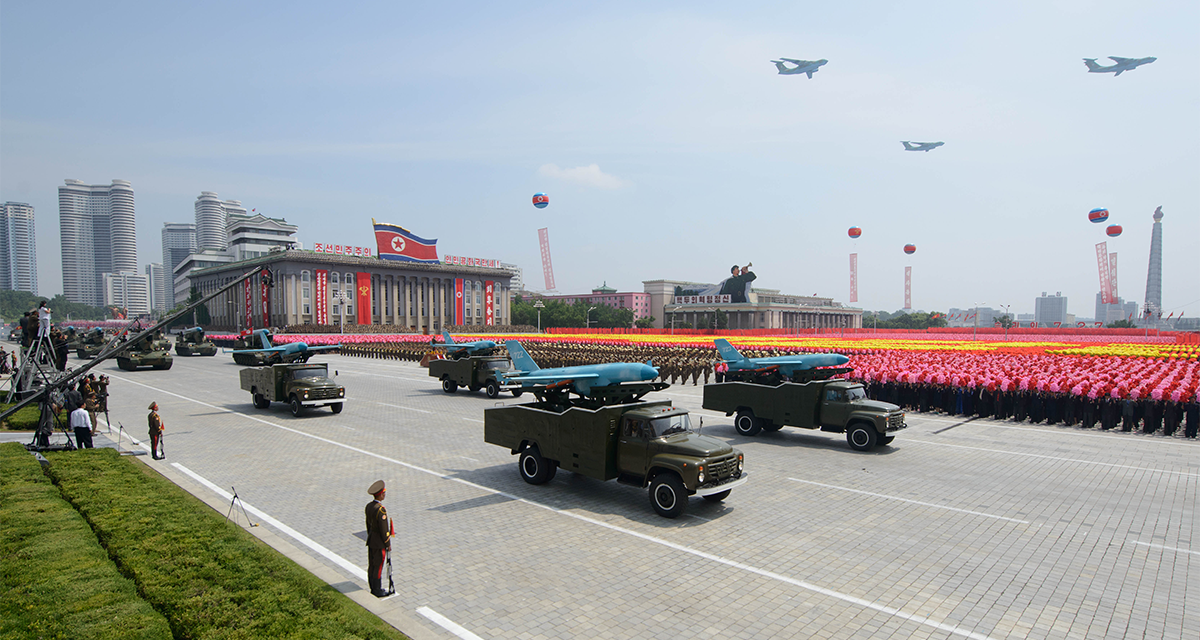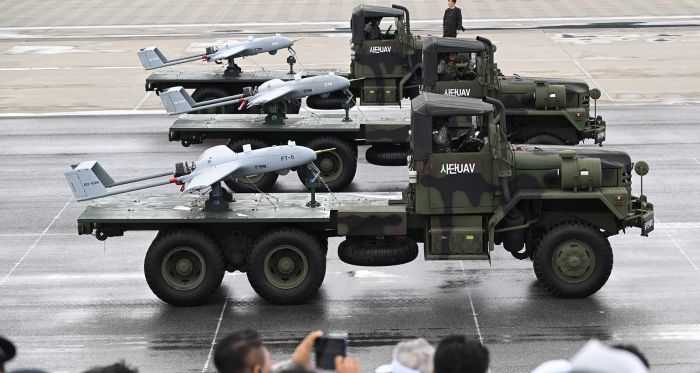Lorsque la Corée du Nord a signé un accord de partenariat avec la Russie en juin 2024, puis déployé des troupes pour aider la Russie dans son invasion de l’Ukraine, la Corée du Sud et ses alliés se sont inquiétés de la manière dont cette nouvelle phase de coopération en matière de sécurité entre Pyongyang et Moscou pourrait renforcer les capacités militaires de la première, au détriment de la sécurité de la Corée du Sud. Une récente émission nord-coréenne a révélé un indice important : des drones nord-coréens fraîchement repeints, signe que les véhicules aériens sans pilote sont devenus un atout stratégique pour la sécurité dans la péninsule coréenne.
L’attaque de la Russie contre l’Ukraine a démontré l’efficacité et la polyvalence des drones. Par exemple, des quadricoptères (des drones commerciaux à quatre rotors) et des munitions rôdeuses (également appelées « drones kamikazes ») abordables ont détruit des colonnes blindées, mis en évidence des lacunes dans la défense aérienne et, dans certains cas, dévasté des quartiers entiers. Les troupes nord-coréennes déployées aux côtés des forces russes ont observé ces tactiques de près et, selon les rapports de services de renseignement alliés, sont rentrées chez elles avec une expertise en matière de production à faible coût, de tactiques d’essaim et de brouillage GPS.
En réponse, la Corée du Sud – qui a été prise par surprise par l’incursion de cinq drones nord-coréens en décembre 2022 – s’empresse de renforcer sa propre « chaîne de destruction des drones », un système de capteur à tireur à plusieurs niveaux qui est capable de détecter, de suivre et de neutraliser en quelques secondes les véhicules aériens sans pilote (UAV) hostiles, tout en investissant dans des logiciels de détection basés sur l’intelligence artificielle (IA) et en déployant des drones rôdeurs polonais Warmate testés au combat.
Cette rivalité croissante dans le domaine des drones ajoute une nouvelle dimension asymétrique à l’impasse militaire entre la Corée du Nord et la Corée du Sud, ce qui a des répercussions sur la sécurité régionale. Les deux Corées doivent désormais repenser leurs doctrines de défense aérienne. Contrairement aux menaces aériennes traditionnelles que représentent les jets pilotés et les missiles, les petits drones volent à basse altitude, échappent aux radars et frappent sans crier gare, obligeant les armées à passer de systèmes centralisés d’interception de missiles à des systèmes dispersés à réaction rapide capables de s’adapter en temps réel.
Évolution de l’utilisation et de la technologie des drones en Corée du Nord
Les premiers drones nord-coréens – des quadricoptères rudimentaires qui se sont écrasés au sud de la zone démilitarisée en 2014 – ont évolué pour former une flotte beaucoup plus diversifiée et performante. Cela comprend les UAV à réaction de classe Saetbyol, ainsi que des essaims de drones à vue subjective dotés d’une caméra qui transmet des images en direct aux lunettes du pilote. Le Saetbyol-4 serait capable de voler à haute altitude et de rester en vol assez longtemps pour balayer la zone démilitarisée afin de repérer les batteries d’artillerie et de missiles. Le Saetbyol-9, une version plus mince, serait capable de transporter des obus à guidage de précision ou de petits missiles de croisière contre ces mêmes cibles. Le trio est complété par des quadricoptères à vue subjective de la taille d’une boîte à chaussures qui sont pilotés par un opérateur à l’aide des images transmises en direct. Ils seraient ainsi en mesure de traverser les vallées, d’échapper à la détection des réseaux radars et de bombarder des cibles avec une charge creuse d’un à deux kilogrammes.
Déployés ensemble, ces drones peuvent être particulièrement meurtriers : le Saetbyol-4 peut localiser des cibles de grande valeur, le Saetbyol-9 peut frapper depuis les airs et les essaims de drones à vue subjective peuvent achever le travail au niveau de la cime des arbres. Cette combinaison de frappes accentue les tensions dans la péninsule et augmente le risque d’une erreur de calcul fatale. Autre fait inquiétant : les médias nord-coréens ont présenté ces drones de fabrication artisanale comme pouvant être déployés sans être entravés par les sanctions de l’ONU.
Des images satellites de l’aérodrome de Panghyon en Corée du Nord révèlent sept nouveaux hangars de 40 mètres et une longue piste adaptée à des aéronefs plus lourds et sans pilote. Pyongyang a également dévoilé des drones kamikazes guidés par l’IA qui utilisent la reconnaissance d’image embarquée pour diriger l’artillerie sans recourir au GPS. Des sources de renseignement occidentales s’adressant aux médias ont attribué ces progrès aux transferts de technologie russes, y compris au moins un système de défense aérienne monté sur camion Pantsir, qui est précieux non pas pour ses missiles, mais pour son logiciel radar capable de suivre de petits quadricoptères à courte portée.

Apparemment, les troupes nord-coréennes auraient rapidement assimilé les enseignements russes en matière de guerre électronique et de tactiques anti-UAV; elles sont désormais capables d’attirer les drones ennemis à l’aide d’un seul soldat servant d’appât, de les détecter à l’aide de sondes portatives et de les neutraliser à courte distance à l’aide de fusils modifiés, tout en se déplaçant en petites équipes dispersées afin d’échapper au suivi aérien. Cette expérience de combat a permis à la Corée du Nord d’affiner sa capacité à utiliser cette nouvelle technologie avec une plus grande précision et une plus grande létalité.
Réaction de la Corée du Sud face aux progrès de la Corée du Nord dans le domaine de la technologie des drones
Les progrès réalisés par la Corée du Sud dans le domaine de la technologie des drones ont suivi une voie différente. Séoul a élaboré sa stratégie autour d’un modèle « bouclier et lance » : mettre en place un réseau dense de défense aérienne pour contrer une première frappe, tout en permettant des représailles à l’aide de drones et de missiles de précision capables de frapper les sites de lancement et les centres de commandement avec une puissance de feu au moins deux fois supérieure.
Après que des drones nord-coréens ont violé l’espace aérien de Séoul en décembre 2022, le ministère sud-coréen de la Défense nationale, avec le nouveau Commandement des opérations de drones, a accéléré la mise en place d’une chaîne de destruction des drones, un système de défense multicouche qui détecte les drones, brouille leurs signaux et les abat à l’aide de puissants lasers. Séoul et, à plus petite échelle, les villes industrielles de Gumi et d’Ulsan, qui abritent certains des plus grands complexes électroniques, de défense, de fabrication automobile et de construction navale de Corée du Sud, renforcent désormais leurs zones industrielles et leurs infrastructures critiques par la mise en place de la première chaîne de destruction des drones au pays, un système de défense multicouche qui associe des capteurs de détection sonore à des lasers à haute énergie.
L’Administration du programme d’acquisition de défense de la Corée du Sud a également commandé des munitions rôdeuses polonaises Warmate (des bombes planantes de la taille d’un sac à dos guidées par tablette) qui sont utilisées par les forces ukrainiennes contre les troupes russes et qui coûtent moins d’un dixième du prix d’un missile guidé ordinaire, en plus des munitions rôdeuses propres à la Corée du Sud. La décision d’importer des systèmes polonais Warmate indique que les leçons tirées du champ de bataille en Ukraine sont en train d’être assimilées en Asie de l’Est. Guidée par l’utilisation antérieure de drones de reconnaissance Heron construits par Israël, l’acquisition de la Corée du Sud crée des occasions de coopération avec des entreprises ukrainiennes et israéliennes spécialisées dans les drones.
Des entreprises nationales, comme Hanwha Aerospace, ont lancé la production à plein régime du laser de défense aérienne Block-I, capable de neutraliser les drones nord-coréens volant à basse altitude, tandis que le nouveau Commandement des opérations de drones de la Corée du Sud relie désormais les drones de reconnaissance aux chars de combat K2 pour un ciblage en temps réel. De son côté, l’armée de l’air sud-coréenne a également abandonné son projet d’achat d’hélicoptères AH-64E Apache, soulignant leur vulnérabilité aux attaques de drones.
Étant donné que la guerre des drones constitue une zone grise qui se situe en dessous des seuils traditionnels d’escalade des conflits, elle brouille la frontière entre les exercices militaires et les actes coercitifs, ce qui oblige Séoul à revoir les manuels de dissuasion qui sont rédigés pour les missiles et les bombardiers pilotés, et non pour les quadricoptères bourdonnants. Les planificateurs de Séoul redéfinissent la dissuasion en misant sur la rapidité, la dispersion et la défense multicouche. De même, les aéronefs de surveillance sont dispersés sur plusieurs pistes d’atterrissage auxiliaires, les aires de trafic sont divisées en « cellules » protégées par des murs pare-souffle et les dépôts de munitions sont recouverts de filets légers afin qu’un petit nombre de quadricoptères ne puissent déclencher une réaction en chaîne.
Ces mesures s’inscrivent dans le prolongement de la décision prise en décembre 2022 d’intégrer des détecteurs acoustiques, des brouilleurs et des lasers dans un réseau anti-drones couvrant l’ensemble de la ville, après que des drones nord-coréens aient pénétré dans l’espace aérien de la capitale. Le nouveau plan d’action ne repose plus sur le principe « encaisser et riposter »; il vise plutôt à empêcher une première frappe grâce à la dispersion et, en cas d’échec, à riposter en quelques minutes avec des essaims consommables qui frappent les sites de lancement avant que les chasseurs classiques ne puissent décoller. La défense de l’espace aérien devient ainsi une succession incessante de manœuvres et de contre-manœuvres plutôt qu’un coup décisif unique.
La technologie des drones et les nouveaux défis en matière de sécurité en Asie de l’Est
Les essaims de quadricoptères à vue subjective lancés à partir de camions par Pyongyang (qui ne coûtent que quelques milliers de dollars chacun) peuvent menacer les bases aériennes sud-coréennes (qui valent des milliards de dollars) à risque minime. Leur petite taille et leur faible signature radar leur permettent d’échapper aux capteurs classiques, tandis que les usurpateurs GPS – de minuscules émetteurs qui transmettent de fausses coordonnées aux systèmes de navigation – les aident à échapper aux missiles intercepteurs à courte portée qui protègent les bases sud-coréennes.
À l’échelle régionale, les drones sont devenus des outils puissants capables de transformer la bande de vol à basse altitude, qui constituait auparavant un angle mort pour les systèmes de défense aérienne, en un espace stratégique disputé. Un seul exercice d’essaimage près de la ligne limite nord – la frontière maritime contestée entre les deux Corées – peut contraindre les équipes radars des États-Unis et du Commandement des Nations Unies à rajuster leurs seuils d’alerte précoce. Par ailleurs, le transfert récent par Moscou d’un système de défense aérienne Pantsir à Pyongyang souligne le renforcement de la collaboration militaire entre la Russie et la Corée du Nord.
Les chaînes d’approvisionnement mondiales compliquent davantage la production de drones en Corée du Sud. Malgré l’initiative K-Drone visant à renforcer son industrie nationale, Séoul est confrontée à une vulnérabilité de sa chaîne d’approvisionnement, car une grande partie des pièces des drones sud-coréens proviennent de la Chine ou sont fabriquées à partir de cellules civiles chinoises. Le dernier régime de licences d’exportation de Beijing a déjà doublé le prix des capteurs et des modules d’alimentation essentiels pour les drones, ce qui a entraîné une augmentation des coûts et un allongement des délais de livraison. Cet arrangement augmente les risques en temps de guerre, car les lignes d’entretien pourraient être coupées du jour au lendemain et les portes dérobées du micrologiciel pourraient exposer les systèmes au piratage à distance ou à l’usurpation GPS.
La course aux drones qui se déroule entre Séoul et Pyongyang a modifié la dynamique de sécurité en Asie du Nord-Est, qui inclut désormais les batteries, les algorithmes et les contre-brouilleurs. Les essaims de drones à faible coût de la Corée du Nord qui bénéficient de l’expertise russe peuvent surveiller les bases aériennes sud-coréennes et saturer les écrans radars, mais leur succès dépend de leur puissance, de leur guidage et de leur limite de charge utile. L’utilisation par la Corée du Sud de lasers, de logiciels de piratage et de munitions rôdeuses pour contrer la Corée du Nord prouve que la dissuasion dépend désormais de cycles technologiques rapides plutôt que de plateformes traditionnelles. Pour les capitales (Séoul, Pyongyang, Washington, Beijing et Ottawa), la leçon est claire : les systèmes sans pilote ne peuvent remplacer les forces terrestres ni la puissance de feu stratégique en raison des limites des batteries, du brouillage, de la bureaucratie et de la fragilité logistique. Toutefois, les drones sont rapidement devenus des atouts militaires indispensables, et leur pouvoir disruptif augmentera de manière exponentielle à mesure que la technologie de navigation basée sur l’IA arrivera à maturité.
Le potentiel de coopération entre le Canada et la Corée du Sud dans le domaine des drones
À la mi-2025, le Canada n’avait pas encore utilisé de drones dans le cadre de l’opération NEON, la mission chargée de surveiller les violations des sanctions commises en mer par la Corée du Nord. Au lieu de cela, il s’appuie sur des patrouilleurs CP-140 Aurora et des navires de guerre transportant des hélicoptères pour assurer la surveillance. Les experts canadiens en matière de défense ont exhorté la Marine royale canadienne à adopter des drones armés pour la surveillance maritime, une option qui serait bénéfique pour des missions comme l’opération NEON. Ottawa et Séoul partagent un intérêt pour la lutte contre les programmes d’armement de Pyongyang et la mise en œuvre des sanctions de l’ONU. Elles coopèrent étroitement dans le cadre d’initiatives de surveillance maritime, qui peuvent être renforcées par l’utilisation de drones.
Le Canada utilise déjà des drones pour surveiller ses frontières et les feux de forêt, ce qui démontre leur utilité dans la surveillance de vastes zones et la réduction des risques pour le personnel. Si les drones sont utilisés dans le cadre de l’opération NEON, les mêmes avantages pourraient améliorer la détection des activités illicites de la Corée du Nord. Les bases sont jetées pour leur utilisation future en tant que multiplicateurs de force dans la boîte à outils canadienne de mise en œuvre des sanctions.
La Corée du Sud est un partenaire tout désigné pour le Canada dans l’adoption de la technologie des drones. Les deux pays ont signé un protocole d’entente concernant la coopération en matière de matériel de défense en 2022 afin d’explorer les possibilités conjointes de recherche, de développement et d’approvisionnement. La guerre en Ukraine a démontré que les drones de pointe dépendent de chaînes d’approvisionnement mondiales complexes pour leurs composants (dont certains proviennent du Canada et de la Corée du Sud), ce qui rend les partenariats technologiques entre alliés plus essentiels que jamais. En associant l’expérience opérationnelle du Canada sur de vastes territoires à la dynamique industrielle de la Corée du Sud, les deux pays peuvent améliorer la surveillance des sanctions, accélérer l’innovation dans le domaine de la technologie des drones et renforcer le cadre de sécurité fondé sur des règles qu’ils soutiennent.


